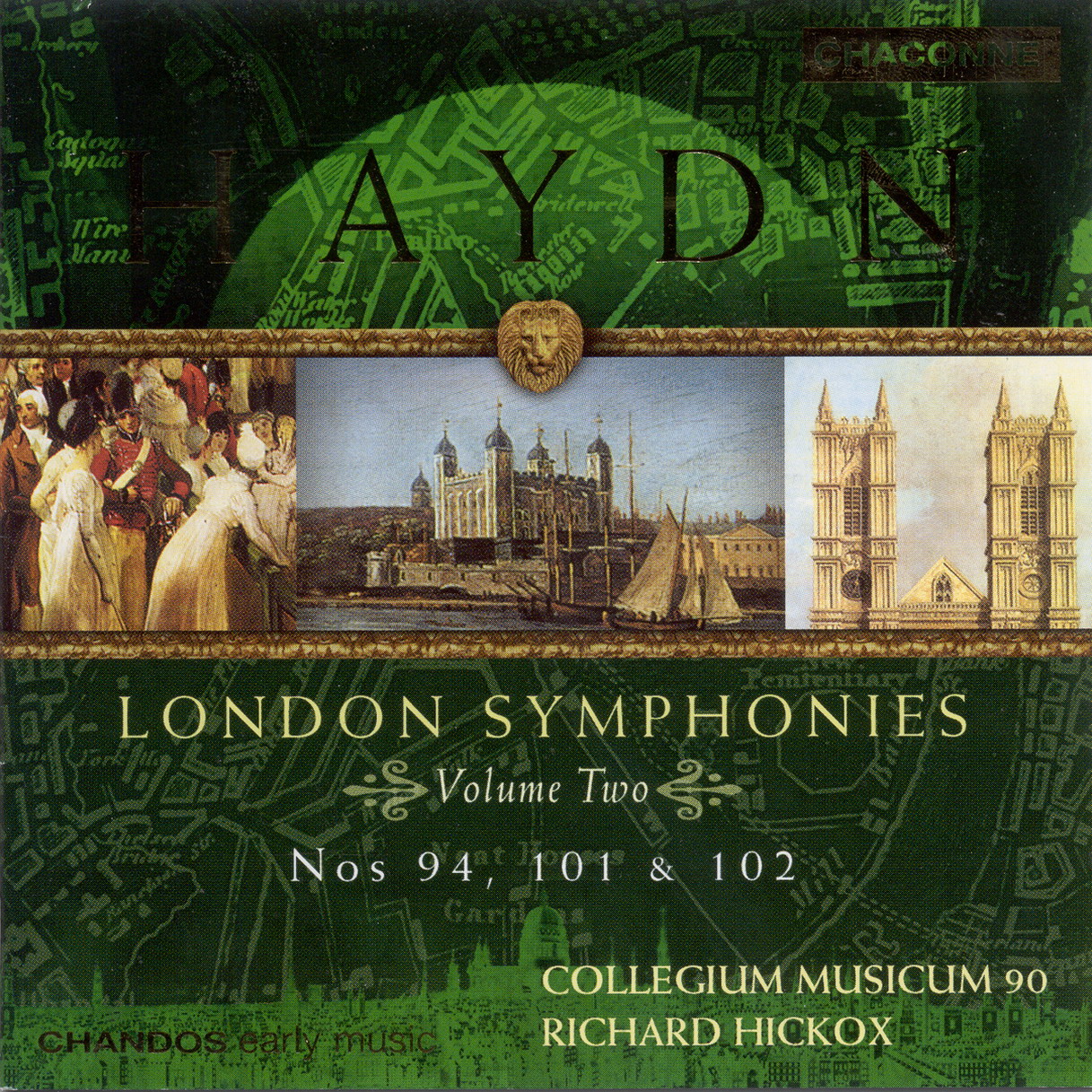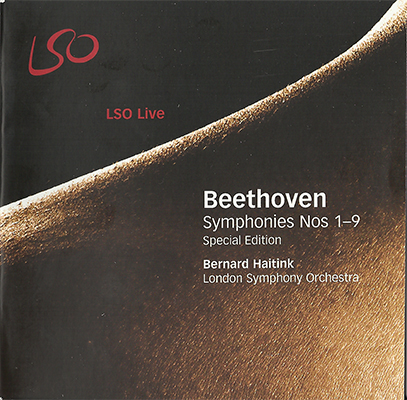
Collegium Musicum 90, Richard Hickox – Haydn: London Symphonies, Vol. 2 (2000)
FLAC (tracks) 24 bit/96kHz | Time – 01:15:11 minutes | 962 MB | Genre: Classical
Studio Masters, Official Digital Download – Source: HDTracks | Digital Booklet | © Chandos
One of the most striking features of the twelve symphonies that Haydn composed for London between 1791 and 1795 is the strong sense of rapport between the composer and the intended audience. It was a popularity that he nurtured so that the tastes and enthusiasm of his audience were gradually developed. – for Haydn, popularity went hand in hand with artistic integrity. The three symphonies recorded here were all premiered in different seasons and reveal these qualities to the full.
Symphony No. 94 was given its first performance on 23 March 1792. It begins with a slow introduction but, unusually, softly with wind instruments, and the 6/8 metre that follows is more commonly associated with finales. The slow movement soon occasioned the name ‘Surprise’ because of the sudden ‘fortissimo’ chords. A minuet and trio follows and in the Finale the mood becomes more and more aggressive in its changes of harmonic direction, its rhythmic energy and orchestral colouring.
Symphony No. 101 received its first performance on 3 March 1794. It was again the slow movement that captured the public’s imagination, the slow ‘ticking’ giving rise to the nickname ‘Clock’. The first movement again uses a 6/8 signature and it is preceded by a dark, slow introduction. The brisk Minuet includes a trio section with a deliberate ‘wrong’ chord, but the ‘mistake’ is corrected second time round. The Finale has an enormous variety of mood, although everything is drawn from the first three notes.
Haydn’s last season in London saw the first performance of Symphony No. 102 on 2 February 1795. It is probably the most cerebral of the twelve ‘London’ symphonies, and although there are points of contact with the other symphonies, there were no ‘gimmicks’ to give it a nickname. The composer’s seriousness is particularly shown in the slow movement which is suffused with expressive performance markings and a variety of orchestral colour that are unequalled in any of his other symphonies. Here is Haydn’s mastery of language and comic timing at its very best.
Tracklist
Joseph Haydn (1732-1809)
1. Symphony No. 101 in D Major, Hob.I:101, “The Clock”*: I. Adagio – Presto 7:51
2. Symphony No. 101 in D Major, Hob.I:101, “The Clock”*: II. Andante 8:16
3. Symphony No. 101 in D Major, Hob.I:101, “The Clock”*: III. Menuetto – Trio: Allegretto 6:29
4. Symphony No. 101 in D Major, Hob.I:101, “The Clock”*: IV. Finale: Vivace 4:57
5. Symphony No. 94 in G Major, Hob.I:94, “The Surprise”: I. Adagio – Vivace assai 8:43
6. Symphony No. 94 in G Major, Hob.I:94, “The Surprise”: II. Andante 6:35
7. Symphony No. 94 in G Major, Hob.I:94, “The Surprise”: III. Menuetto – Trio: Allegro molto 4:16
8. Symphony No. 94 in G Major, Hob.I:94, “The Surprise”: IV. Finale: Allegro di molto 4:05
9. Symphony No. 102 in B-Flat Major, Hob.I:102: I. Largo – Vivace 8:24
10. Symphony No. 102 in B-Flat Major, Hob.I:102: II. Adagio 5:27
11. Symphony No. 102 in B-Flat Major, Hob.I:102: III. Menuet – Trio: Allegro 5:04
12. Symphony No. 102 in B-Flat Major, Hob.I:102: IV. Finale: Presto 4:51
Personnel:
Collegium Musicum 90 – Ensemble
Richard Hickox – Conductor
Recorded January 27th-29th, 2000 at Blackheath Halls in London, UK
Download:
mqs.link_HaydnLndnSymphniesVl.2CllegiumMusicum90RichardHickx20002496HDtracks.rar



















![Philippe Herreweghe & Collegium Vocale Gent - Bach: Motetten (2011) [Qobuz FLAC 24bit/44,1kHz] Philippe Herreweghe & Collegium Vocale Gent - Bach: Motetten (2011) [Qobuz FLAC 24bit/44,1kHz]](https://getimg.link/images/imgimgimg/uploads/2019/07/9cXYupj.jpg)
![Sir Simon Rattle, Berliner Philharmoniker - Jean Sibelius - Symphonies Nos. 1-7 (2015) [Blu-ray Disc + Pure Audio Blu-ray Disc + FLAC 5.1 24bit/192kHz] Sir Simon Rattle, Berliner Philharmoniker - Jean Sibelius - Symphonies Nos. 1-7 (2015) [Blu-ray Disc + Pure Audio Blu-ray Disc + FLAC 5.1 24bit/192kHz]](https://getimg.link/images/imgimgimg/uploads/2016/02/htbd2jO.jpg)
![Piers Lane, Howard Shelley - Williamson: Complete Piano Concertos (2014) [FLAC 24bit/96kHz] Piers Lane, Howard Shelley - Williamson: Complete Piano Concertos (2014) [FLAC 24bit/96kHz]](https://getimg.link/images/imgimgimg/uploads/2017/01/PsKdW8Y.jpg)
![London Symphony Orchestra & Richard Hickox - Vaughan Williams: A London Symphony (2001) [FLAC 24bit/96kHz] London Symphony Orchestra & Richard Hickox - Vaughan Williams: A London Symphony (2001) [FLAC 24bit/96kHz]](https://getimg.link/images/imgimgimg/uploads/2018/01/6087ypy.jpg)
![Adrian Butterfield - Handel: Chandos Te Deum - Chandos Anthem No. 8 (2018) [FLAC 24bit/96kHz] Adrian Butterfield - Handel: Chandos Te Deum - Chandos Anthem No. 8 (2018) [FLAC 24bit/96kHz]](https://getimg.link/images/imgimgimg/uploads/2019/10/Y2GdBYB.jpg)
![Pacifica Quartet - Dmitri Shostakovich and his Contemporaries: The Soviet Experience Vol. 1-4 (2011-2013) [24bit FLAC] Pacifica Quartet - Dmitri Shostakovich and his Contemporaries: The Soviet Experience Vol. 1-4 (2011-2013) [24bit FLAC]](https://getimg.link/images/imgimgimg/uploads/2017/07/ntIbtOp.jpg)
![Carl Nielsen - Symphonies Nos. 1-6 - London Symphony Orchestra, Sir Colin Davis (2015) [Blu-Ray Pure Audio Disc + DSF Stereo DSD64/2.82MHz] Carl Nielsen - Symphonies Nos. 1-6 - London Symphony Orchestra, Sir Colin Davis (2015) [Blu-Ray Pure Audio Disc + DSF Stereo DSD64/2.82MHz]](https://getimg.link/images/imgimgimg/uploads/2015/09/Wnf48VE.jpg)

![Sir Colin Davis, London Symphony Orchestra - Haydn: Symphonies Nos. 92 & 93, 97-99 (2014) [Qobuz FLAC 24bit/96kHz] Sir Colin Davis, London Symphony Orchestra - Haydn: Symphonies Nos. 92 & 93, 97-99 (2014) [Qobuz FLAC 24bit/96kHz]](https://getimg.link/images/imgimgimg/uploads/2017/08/O1wILBY.jpg)
![Howard Shelley, London Mozart Players - Kozeluch: Piano Concertos Nos 1, 5 & 6 (2016) [Hyperion FLAC 24bit/96kHz] Howard Shelley, London Mozart Players - Kozeluch: Piano Concertos Nos 1, 5 & 6 (2016) [Hyperion FLAC 24bit/96kHz]](https://getimg.link/images/imgimgimg/uploads/2019/01/m7LdDI0.jpg)
![Rachel Podger, Gary Cooper - Mozart: Complete Sonatas for Keyboard & Violin (2004-09) [DSF DSD64/2.82MHz] Rachel Podger, Gary Cooper - Mozart: Complete Sonatas for Keyboard & Violin (2004-09) [DSF DSD64/2.82MHz]](https://getimg.link/images/imgimgimg/uploads/2018/08/CtydJ1g.png)
![Johann Sebastian Bach - Secular Cantatas, Vol. 5 ‘Birthday Cantatas’ - Bach Collegium Japan, Masaaki Suzuki (2015) [eClassical FLAC 24bit/96kHz] Johann Sebastian Bach - Secular Cantatas, Vol. 5 ‘Birthday Cantatas’ - Bach Collegium Japan, Masaaki Suzuki (2015) [eClassical FLAC 24bit/96kHz]](https://getimg.link/images/imgimgimg/uploads/2017/03/20Fy4vI.jpg)
![Zuzana Ruzickova - J.S. Bach: The Complete Keyboard Works (2016) [FLAC 24bit/96kHz] Zuzana Ruzickova - J.S. Bach: The Complete Keyboard Works (2016) [FLAC 24bit/96kHz]](https://getimg.link/images/imgimgimg/uploads/2018/09/r94XYtX.jpg)
![Collegium Musicum Pragense - Druzecky, Vent & Vranicky: Hunting Music (2018) [FLAC 24bit/192kHz] Collegium Musicum Pragense - Druzecky, Vent & Vranicky: Hunting Music (2018) [FLAC 24bit/192kHz]](https://getimg.link/images/imgimgimg/uploads/2018/09/eibPpL4.jpg)
![Rachel Podger, Jane Rogers - Mozart, Haydn: Duo Sonatas (2011) [DSF DSD64/2.82MHz] Rachel Podger, Jane Rogers - Mozart, Haydn: Duo Sonatas (2011) [DSF DSD64/2.82MHz]](https://getimg.link/images/imgimgimg/uploads/2019/01/VkhN8EH.jpg)